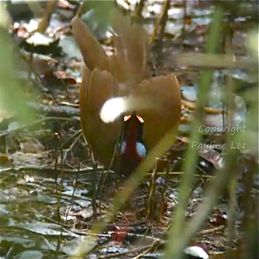On 29th June 2009, Pauline Lee wrote: “Was very fortunate in yesterday’s Panti outing to be able to see a pair of Malaysian Rail-Babblers (Eupetes macrocerus). Having heard the bird’s characteristic monotone whistle call on previous occasions but never able to see it, remarkably, this time the birds were calling near the road. They were foraging on the forest floor near a small stream bed. We captured this video [HERE] just at the side of the Bunker track.
“Each bird took alternate turns to call to each other in close proximity. And during vocalisation, they raised the tail, spread the wings and stretched the neck down while holding the bill upwards. Only when the throat inflates do you obviously see the blue throat patches (left). After repeated calls to each other, one bird then dropped to a lower pitch and then both stopped. After which they moved apart and a while later, one was seen to run back and forth.
“An interesting observation was that in between the calling sessions, they made soft clicking/clucking sounds while feeding off the ground. Detectable only because of the close range.”
The Rail-babbler, also known as the Malaysian Rail-babbler, is a resident of the rainforests of Malaysia. It is not found in Singapore. This bird seldom flies, preferring to walk on the forest floor. It forages on the ground, walking and dashing about in pursuit of preys. Even when disturbed, it is reluctant to fly, as it can dash through the forest undergrowth just as rapid as a squirrel.
It usually remains concealed among the thick vegetation, often heard than seen. It emerges only to sing, and this apparently gave Pauline the rare opportunity to document the pair in Panti.
During vocalising, the bird performs unusual posturing as it selects a vantage position on a fallen log. It bends its legs, lowers its body until it touches the surface where it is standing on. It stretches its neck and head forward and raises its tail. It bobs up and down. As the bird sings, it inflates an area of bare skin on the throat. The duetting is alternating, the male and female contributing different phrases that together form the complete song.
Much is unknown of the bird and any little that has been observed needs to be documented. Pauline’s observation is probably a territorial display.
Morten Strange has this to add: “It appears to me to be two competing males. There are quite a few territories in the Panti area and these two have areas bordering close to each other. I don’t see any sign of permissive ‘feminine’ behaviour, these are two combatives pumped up with testosterone and calling away, showing off the characteristic blue throat pouch; among passerines the male calls mainly for territorial reasons and to attract a female. The other social ‘clucking’ call while feeding is an interesting observation.
“Kim Chuah was the first to describe the Rail-babbler’s display in the Avifauna many years ago, both Subaraj and Ding Li knows the bird better than I do. But yes… this is how it looks when it calls, great documentation, many twitchers travel to Panti and Taman Negara to experience this, well done video, it should be on HBW’s video-site!”
I am sure Lim Kim Chuah would have shared his experience in the forum wildbirdSingapore where Pauline appealed for “Any comments or insights into the behaviour?”
The problematic taxonomy of the Rail-babbler can be found HERE.
Image is a screen grab from Pauline Lee’s video.
Reference:
Boles, W. E., 2007. Family Eupetidae (Jewel-babblers and allies). In: del Hoyo, J., A. Elliott & J. Sargatal (eds.). Handbook of the birds of the world. Vol. 12. Picathartes to Tits and Chikadees. Lynx Editions, Barcelona. Pp. 348-373.










2 Responses
That is fantastic! I love the video.
Wow, how wonderful. This is a strange and fascinating bird — thanks for the glimpse into its life.